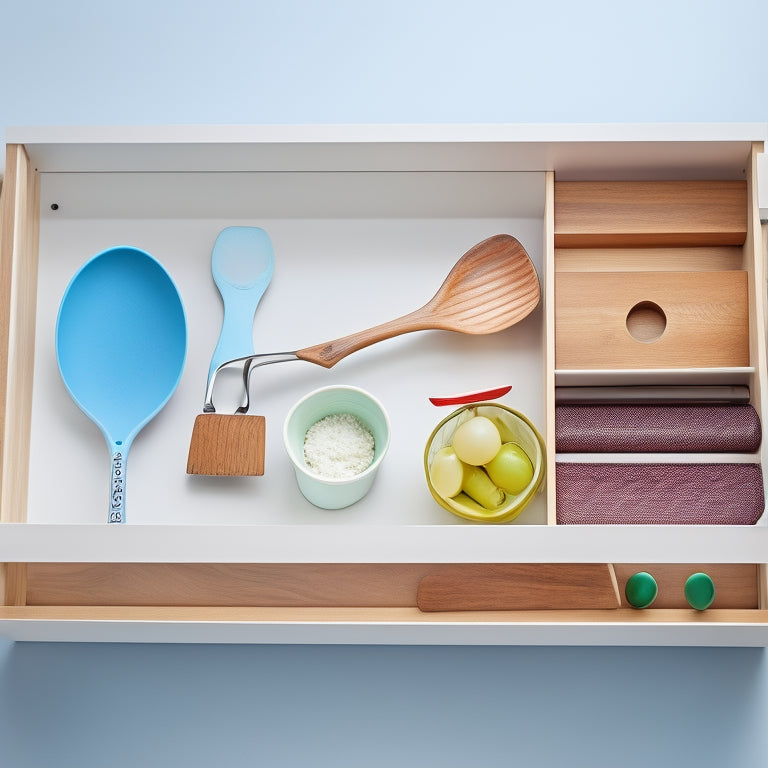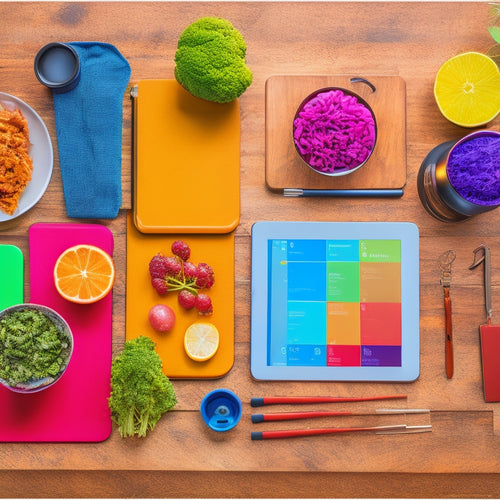
3 DIY Hacks for Clutter-Free Kitchen Drawers
Share
You can reclaim your kitchen drawers by maximizing space with adjustable dividers or inserts that create separate compartments and prevent clutter. Create customized storage containers tailored to your specific needs, using durable materials and labeling them for easy identification. Take your storage to new heights by utilizing vertical space with stackable shelves, magnetic boards, or hanging organizers. By implementing these DIY hacks, you'll be well on your way to a clutter-free kitchen. Now, get ready to discover even more clever ways to optimize your kitchen drawers and say goodbye to clutter for good.
Key Takeaways
• Utilize adjustable dividers or inserts to create separate compartments within drawers and prevent clutter accumulation.
• Craft customized storage containers for kitchen gadgets and accessories to assign designated homes for items.
• Opt for durable and easy-to-clean materials for containers and label them for easy identification and maintenance.
• Maximize vertical space within drawers by installing stackable shelves or trays to store items like spices and utensils efficiently.
• Customize dividers to fit specific needs and maintain organization with clear labels to facilitate easy item retrieval.
Maximizing Drawer Space With Dividers
Use adjustable dividers or inserts to carve out separate compartments within your kitchen drawers, allowing you to allocate space according to the size and shape of your items. This simple hack will prevent clutter from building up and make it easier to find what you need when you need it.
For instance, you can dedicate a compartment to utensils, another to spices, and a third to cooking oils. Adjustable inserts are particularly useful as they can be customized to fit your specific needs.
When choosing dividers, consider opting for soft-close organizers that will prevent drawers from slamming shut, minimizing the risk of accidents and injuries. By maximizing your drawer space with dividers, you'll be able to store more items efficiently, keeping your countertops clear and your kitchen organized.
This DIY hack requires minimal effort but yields significant results, making it a great starting point for your kitchen organization project. By implementing this simple yet effective solution, you'll be well on your way to achieving clutter-free kitchen drawers.
Creating Customized Storage Containers
By crafting customized storage containers, you'll be able to corral clutter-prone items like kitchen gadgets, cords, and accessories, and assign a designated home for each one. This DIY approach allows you to tailor your storage solutions to your specific kitchen needs.
When selecting materials, opt for durable, easy-to-clean options like plastic bins, wooden crates, or woven baskets. Consider the size and shape of the items you'll be storing, as well as the available space in your kitchen drawers.
For Label Options, use a label maker or stickers to identify what's inside each container. This will make it easy to find what you need at a glance and maintain your newly organized space. You can also add a decorative touch with chalkboard labels or colorful stickers. Remember to choose labels that are easy to read and won't fade over time.
With your customized storage containers in place, you'll be able to maintain a clutter-free kitchen and enjoy a more efficient cooking experience.
Utilizing Vertical Storage Solutions
You can maximize your kitchen drawer's vertical space by installing stackable shelves, baskets, or trays that allow you to store more items without sacrificing accessibility. This is especially useful for storing items like spices, oils, or utensils that you don't use frequently. By utilizing vertical storage solutions, you can keep your kitchen drawers organized and clutter-free.
Here are some ideas to get you started:
-
Install a magnetic board on the back of a cabinet door or on a wall to store metal items like knives, spices, or oils.
-
Use hanging organizers to store items like pots, pans, or utensils, keeping them off the countertops and out of the way.
-
Add stackable drawers or shelves to store dry goods, cleaning supplies, or cooking utensils.
- Consider using adjustable dividers to separate items within a drawer, keeping similar items together and making them easy to find.
Frequently Asked Questions
What Is the Best Material for DIY Drawer Dividers?
"Thou seeketh the perfect material for DIY drawer dividers? You'll find plywood options offer durability, while acrylic benefits include easy cleaning and visibility. Opt for 1/4-inch thick, sanded plywood or clear acrylic sheets for a sturdy, safe, and stylish solution."
Can I Use Contact Paper to Line My Kitchen Drawers?
You can use contact paper to line your kitchen drawers, considering aesthetics matter. With numerous pattern options available, choose one that complements your decor. Confirm the paper is heat-resistant and non-toxic to guarantee a safe and stylish result.
How Do I Prevent Drawer Organizers From Shifting Around?
To prevent drawer organizers from shifting, you'll want to use drawer weights or adhesive-backed Sliding stops to keep them in place, ensuring your kitchen stays organized and safe from clutter-related accidents.
Are Stackable Containers Really Worth the Investment?
You'll find stackable containers worth the investment if you prioritize space savers and superior container quality. Look for durable, BPA-free materials and secure lids to guarantee safe storage, and you'll enjoy a clutter-free kitchen for years to come.
Can I Use Adhesive Hooks in My Kitchen Drawers?
You can use adhesive hooks in your kitchen drawers if you carefully plan hook placement to avoid weight overload and make sure the hooks are durable enough to hold the intended items, taking into account factors like humidity and temperature.
Related Posts
-

7 Best Meal Planning Tools for Special Diets Online
You've got specific dietary needs, and meal planning can be overwhelming. Fortunately, you're not alone, and online t...
